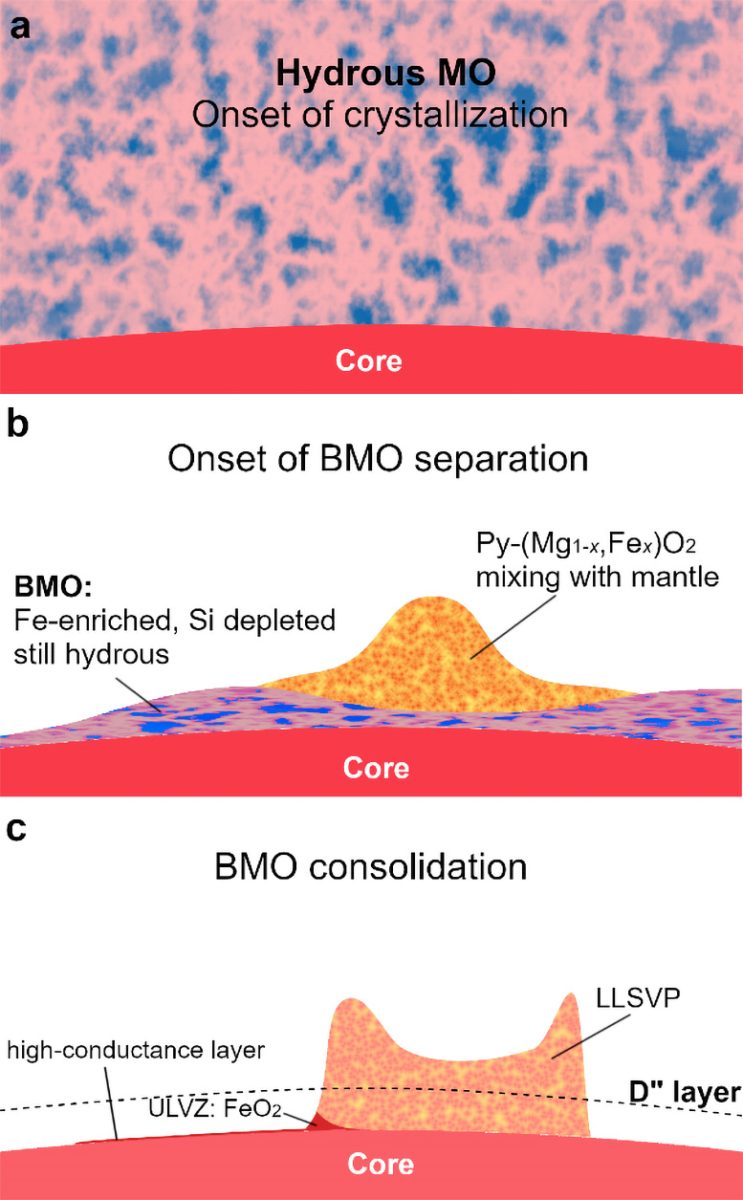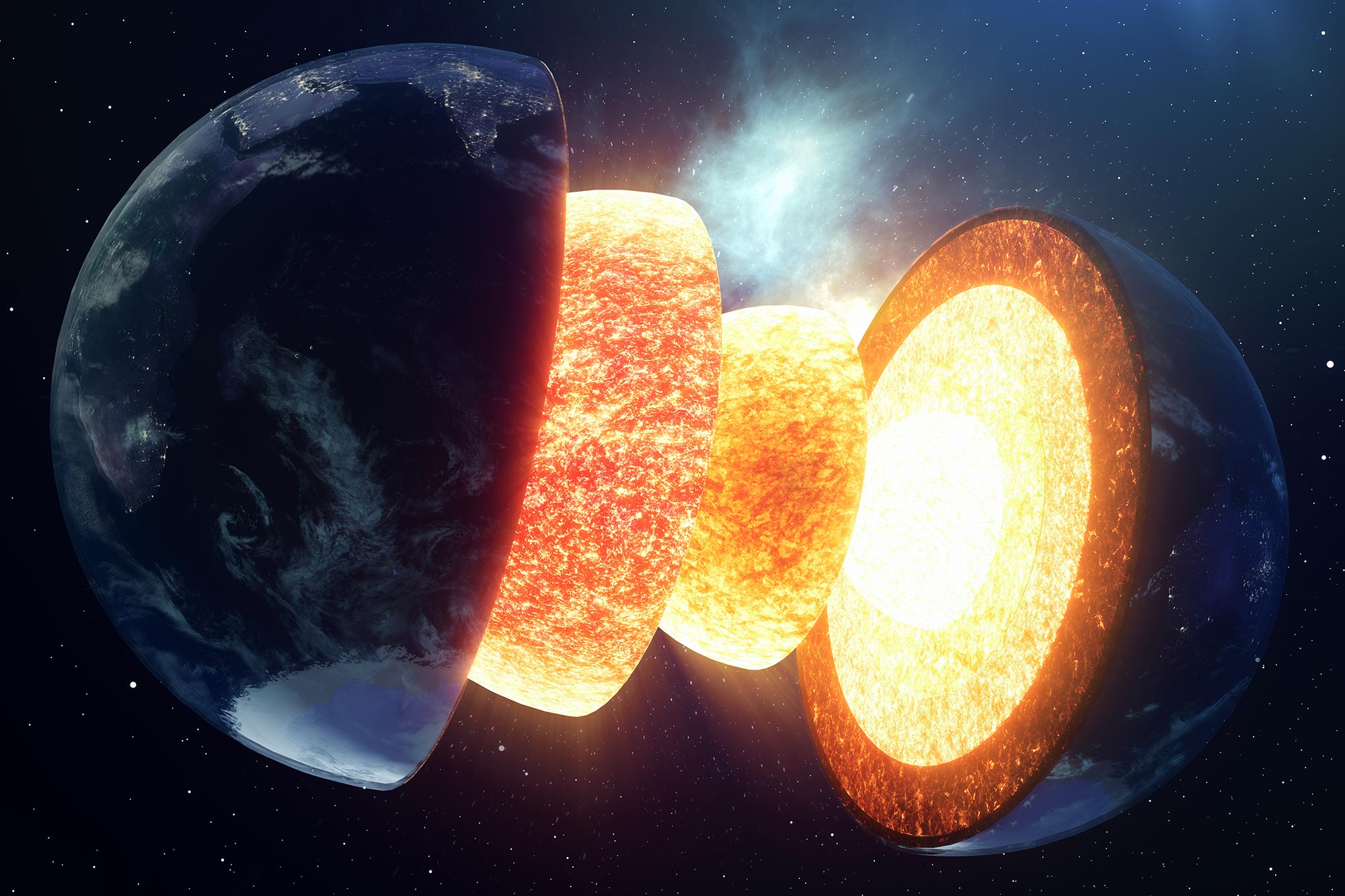A study suggests that Earth's D layer, near the core-mantle boundary, was formed from a magma ocean created by a massive impact. Iron and magnesium peroxide, formed from water in this ocean, explains the unique composition and heterogeneity of layer D.
New research suggests that the mysterious D layer at the Earth's core-mantle boundary may have formed from the remains of an early massive impact, with iron-rich peroxide playing a key role in its unique and enduring features.
Deep inside the Earth, there is a mysterious layer called the D layer. This region is located at a depth of approximately 3,000 kilometers, and lies above the boundary between the planet's molten outer core and its solid mantle. Unlike a perfect sphere, the “D” layer is surprisingly incomplete. Its thickness varies greatly from place to place, and some areas even lack a “D” layer altogether – just as continents rise above the Earth's oceans. These interesting differences have caught the attention of geophysicists, who have described layer D as a heterogeneous, or non-uniform, area.
A new study led by Dr. Qingyang Hu (High Pressure Science and Advanced Technology Research Center) and Dr. Jie Ding (Princeton University) indicates that layer D may have originated from the early days of the Earth. Their theory is based on the giant impact hypothesis, which suggests a MarsA large-sized object collided with the proto-Earth, creating a planet-wide magma ocean in its aftermath. They believe that layer D may be a unique composition of the remains of this massive impact, potentially holding evidence of the formation of the Earth.
Water in the magma ocean
Dr. Jie Ding highlights the presence of a large amount of water within this global magma ocean. The exact origin of this water remains a topic of debate, as various theories have been proposed including its formation through interactions between nebula gas and magma, or direct delivery by comets. “The prevailing view is that the water was concentrated toward the bottom of the magma ocean as it cooled,” Dr. Ding continues. By the final stages, the magma closest to the core may have contained amounts of water similar to that found in Earth's present-day oceans.
The extreme pressure and temperature conditions within the lower magma ocean would have created a unique chemical environment, promoting unexpected interactions between water and minerals. “Our research suggests that this watery magma ocean contributed to the formation of an iron-rich phase called iron-magnesium peroxide,” explains Dr. Qingyang Hu. This peroxide, with the formula (Fe, Mg)O2, has a stronger preference for iron than other major components expected in the lower mantle. “According to our calculations, its binding to iron could have led to the accumulation of iron peroxide in layers ranging from several to tens of kilometers thick.

Formation of a heterogeneous structure at the boundaries of the Earth's core mantle. Credit: China Science Press
The presence of an iron-rich peroxide phase would alter the mineral composition of the D layer, deviating from our current understanding. According to the new model, the minerals in D would be dominated by a new group: iron-poor silicates, iron-rich peroxides (Fe, Mg), and iron-poor oxides (Fe, Mg). This iron-dominated peroxide also has low seismic velocities and high electrical conductivity, making it a likely candidate to explain the unique geophysical features of layer D. These features include regions of extremely low velocity and highly conductive layers, both of which contribute to the known compositional heterogeneity of layer D.
“Our findings indicate that iron-rich peroxide, formed from ancient water within the magma ocean, played a crucial role in the formation of the heterogeneous structures of the D layer,” Qingyang said. The strong affinity of this peroxide for iron creates a stark contrast in density between these iron-rich patches and the surrounding mantle. Essentially, it acts as an insulator, preventing them from mixing and potentially explaining the long-term heterogeneity observed at the base of the lower mantle. “This model agrees well with recent numerical modeling results, suggesting that lower mantle heterogeneity may be a long-term feature,” Ji added.
Reference: “Earth's core-mantle boundary formed by crystallization of a water ocean from terrestrial magma” by Qingyang Hu, Ji Ding, Yucai Zhuang, Zhenzhong Yang, and Rong Huang, May 13, 2024, National Science Review.
doi: 10.1093/nsr/nwae169

“Extreme travel lover. Bacon fanatic. Troublemaker. Introvert. Passionate music fanatic.”






More Stories
Who is the band Gojira that will perform at the Olympics opening ceremony?
SpaceX Moves Crew Dragon Spacecraft to West Coast After Multiple Space Debris Incidents
Stathis Karapanos – Hindemith Review: Complete Works for Flute